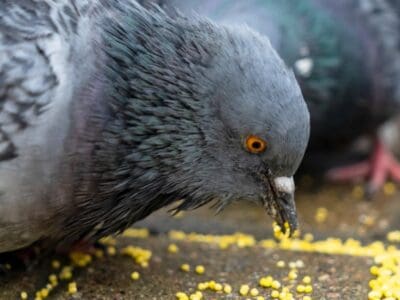Black Mamba
D. polylepis
Black mambas are the longest venomous snake in Africa, and second longest in the world.
Advertisement
Black Mamba Scientific Classification
- Kingdom
- Animalia
- Phylum
- Chordata
- Class
- Reptilia
- Order
- Squamata
- Family
- Elapidae
- Genus
- Dendroaspis
- Scientific Name
- D. polylepis
Read our Complete Guide to Classification of Animals.
Black Mamba Conservation Status
Black Mamba Facts
- Prey
- Bush babies, hyraxes, birds and their young, mammals, occasionally other snakes.
- Main Prey
- Birds and their young
- Name Of Young
- Hatchlings
- Group Behavior
- Solitary
- Fun Fact
- Black mambas are the longest venomous snake in Africa, and second longest in the world.
- Most Distinctive Feature
- The inside of a black mamba's mouth is black.
- Temperament
- Skittish, and prone to strike out of fear.
- Predators
- Secretary birds, brown snake eagles, tawny eagles, and other birds of prey; honey badgers, mongooses, and Nile crocodiles.
- Diet
- Carnivore
- Lifestyle
- Diurnal
View all of the Black Mamba images!
Natives of sub-Saharan Africa, black mambas are widely feared as the most dangerous snake in the world; but do they deserve the reputation?
Yes, their venom is deadly; in fact, as little as 15-20 mg is a lethal dose and yet they inject up to 280 mg when they strike. Yet, they’re shy, and not generally aggressive until they’re cornered; feeling the need to defend themselves.
They spend much of their waking time hunting for prey, they seem to prefer mammals but will eat a wide variety of animals, including other snakes. They are diurnal and forage during the day, then return to the same den to rest at night.
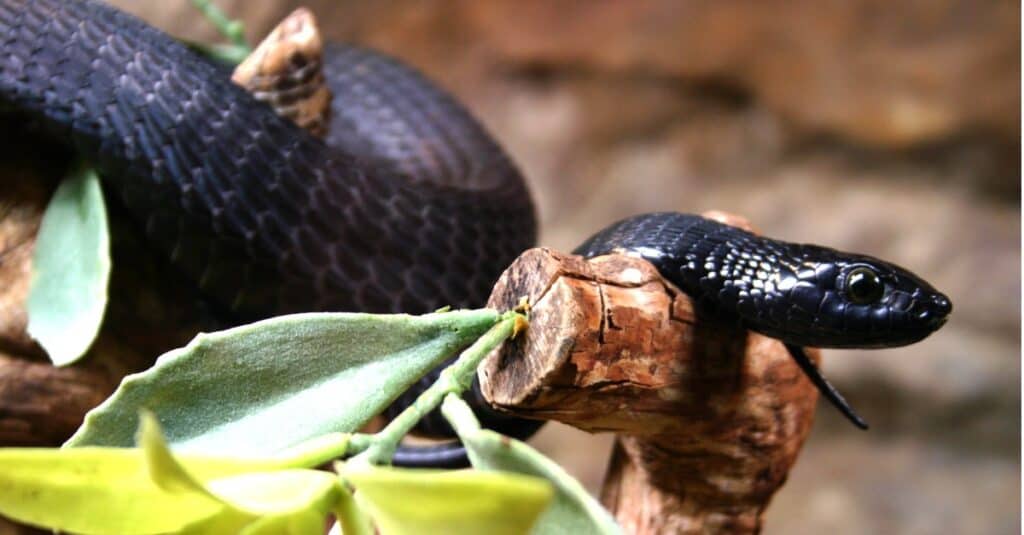
Black Mambas spend much of their waking time hunting for prey, they seem to prefer mammals but will eat a wide variety of animals, including other
snakes
.
©iStock.com/Nicole_Marschall
5 Amazing Black Mamba Facts
- They can grow to 6 feet long within their first year.
- Like their cobra cousins, they have a very thin hood that they display when they feel threatened.
- They’ve been clocked at up to 7 miles per hour, and some believe they may be able to move even faster in short periods.
- A snake may inject up to 280 mg of venom with one attack, but only 15-20 mg can be fatal.
- One victim required 20 vials of antivenom, but fully recovered.

Where To Find Them
These adaptable snakes inhabit a wide range in sub-Saharan Africa. They tend to prefer light woodland and scrub, rocky outcrops, and semi-arid savanna, but also inhabit lowland forests and moist savanna. Black mambas retreat to the same den and only change if it’s disturbed.
They’re widely distributed throughout sub-Saharan Africa and seem to be most common in southern and eastern Africa. You can also find black mambas in Burkina Faso, Cameroon, Central African Republic, the Democratic Republic of the Congo, South Sudan, Ethiopia, Eritrea, Somalia, Kenya, Uganda, Tanzania, Burundi, Rwanda, Mozambique, Eswatini, Malawi, Zambia, Zimbabwe, Botswana, South Africa, Namibia, and Angola.
Their prey includes bush babies, hyraxes, birds, and their young, mammals, and occasionally other snakes; they are opportunistic and prefer mammals but will eat whatever they can get their mouths around. Instead of striking and holding onto their prey, they bite and release it; hanging back until the animal becomes incapacitated or dies.
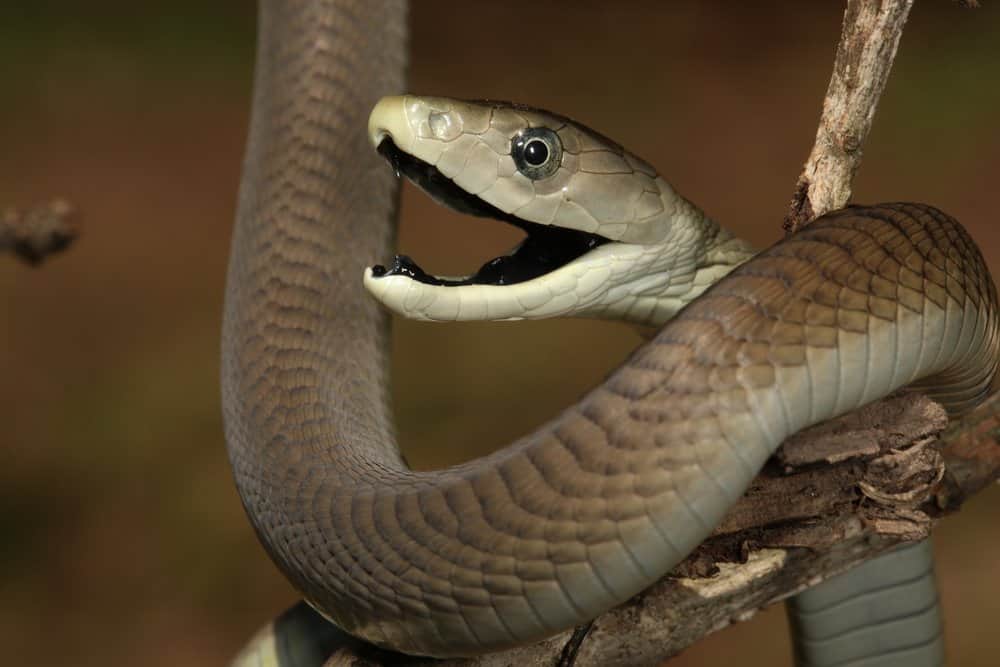
Black Mambas are widely distributed throughout sub-Saharan Africa and seem to be most common in southern and eastern Africa.
©NickEvansKZN/Shutterstock.com
Scientific Name
Dendroaspis polylepis, known as black mambas, are members of the Elapidae family along with King Cobras and coral snakes. Their scientific name is from ancient Greek, Dendroaspis, means tree asp (dendro = tree + aspis = asp); asp is a generic term once used to describe any venomous snake. Polylepis is also from ancient Greek poly for many and lepis for scale. So, the Dendroaspis polylepis means the “Many-scaled tree asp.”
Their common name, mamba, is a borrowed word from either Swahili or Zulu; they’re also called black mouthed mambas.
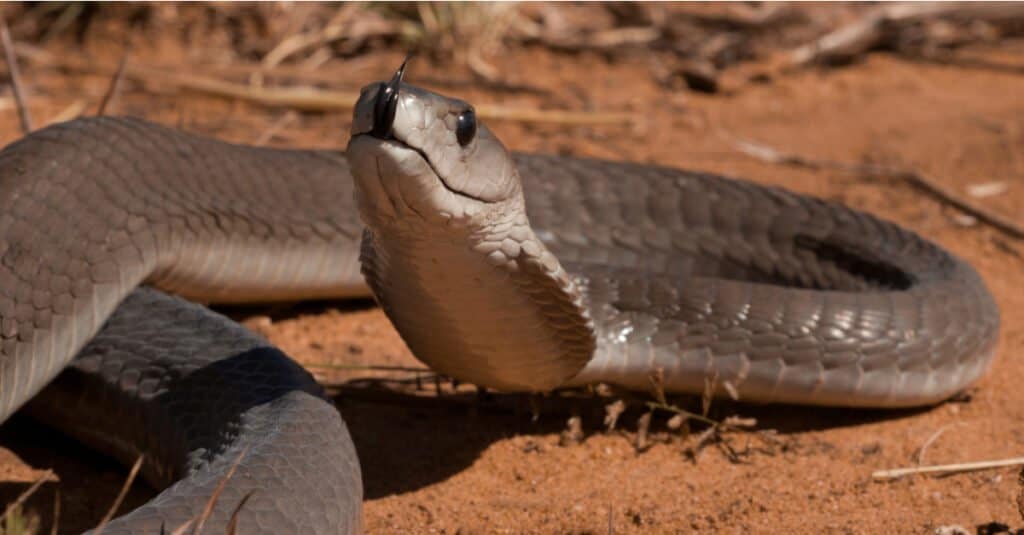
is the scientific name of black mambas.
©131346563/Shutterstock.com
Types of Mambas
- Eastern green mamba (Dendroaspis angusticeps) makes its homes in the coastal rain forests of East Africa.
- Western green mamba (Dendroaspis viridis) inhabits coastal rain forests of West Africa.
- Black mamba (Dendroaspis polylepis) is both terrestrial and arboreal, inhabiting savanna, woodland, rocky slopes, and forests of sub-Saharan Africa
- Jameson’s mamba (Dendroaspis jamesoni) looks similar to Western Green Mambas and inhabits areas of western and central Africa.
History and Evolution
The Black Mamba has evolved several adaptations that help this snake thrive in its environments in Africa.
Like other snakes, this mamba’s sense of smell and taste allows it to locate prey with precision and accuracy. It also helps this snake detect other risks such, as predators, and gives it time to hide or vacate the premises.
Another feature that helps this mamba deal with threats, is its hood structure. Like other elapids, the Black Mamba will flare out the hood on its head and neck to make itself appear larger and try to scare off a predator. This is acutally accomplished with elongated ribs and additional, specialized skin on its neck area.
Finally, the Black Mamba, as a proteroglyph, has fangs that do not retract back into the mouth and are basically fixed in place. Because of this, its fangs are shorter than some other vipers and allow the mamba to not pierce the bottom of its mouth as it closes it.
Population & Conservation Status
There is no evidence that their population is in danger, and due to its very large range throughout sub-Saharan Africa, their status on IUCN Redlist is Least Concern. Their main threats are from people, who fear the snakes and their aggressive reputation.
While black mambas are often killed out of fear by the people who live near them, their main predators are mongooses, honey badgers, birds such as brown snake eagles, secretary birds, and black-headed herons. They’ve also been known to find their way into the bellies of crocodiles.

Black mambas grow quickly, and within 1 year of hatching can reach 6 feet in length.
©NickEvansKZN/Shutterstock.com
How To Identify Them: Appearance and Description
These snakes are long and slender, and like their other Mamba cousins, have a coffin-shaped head. They vary in color and can be olive, yellowish-brown, khaki, and gunmetal gray – they are rarely black and have grayish-white bellies. It’s their mouths that give them the “Black” Mamba moniker, specifically, the inside. It ranges from dark bluish-gray to nearly black. Black Mambas are front-fanged, their fangs can be ¼ inch-long and do not retract.
Black Mambas are the second-longest venomous snake in the world after King Cobras. These long, slender snakes regularly reach 9 feet long, and there are reports of a few individuals reaching over 14 feet. They have medium-sized eyes with round pupils with eyes that range in color from grayish-brown to various shades of black. Even juveniles can be very long, often reaching 6 feet long in their first year after hatching.
Videos
Venom: How Dangerous Are They?
Black mambas are highly venomous and have a reputation for aggression. In addition, their venom is a fast-acting type of venom, similar to other mambas. Mostly made up of neurotoxins, bite victims often begin to show symptoms within the first 30 minutes after a bite.
This snake injects a high volume of venom and strikes repeatedly. So, when a person does get bit by one, there’s a higher probability of death without treatment.
According to the African Snakebite Institute, a study of all the reported snakebites in South Africa over the course of 5 years determined that black mambas averaged just one bite per year. Are they dangerous? Absolutely; but are they aggressive? Probably not.
Symptoms of a Bite
According to Symptoma.com, black mambas are one of the most common venomous snakes in Tanzania. Symptoms progress rapidly and include:
- At the snakebite site there may be pain, warmth, hemorrhagic swelling, and tissue necrosis.
- Other, more general symptoms of venom toxicity can include nausea, trouble swallowing, seizures, delirium, and coma.
There’s good news in all that bad, despite that reputation for aggression, black mamba bites are very rare, and they only attack if threatened or cornered. Black mambas simply would rather retreat than fight.

Black mamba bites are very rare, and they only attack if threatened or cornered.
©reptiles4all/Shutterstock.com
Behavior & Humans
This snake is feared and often killed by people because of its aggressive reputation. However, it’s more likely that it’s unpredictable due to its nervous nature. It’s a skittish snake that doesn’t tolerate humans approaching too closely, and will most likely try to hide or escape first. It’s only when a black mamba feels threatened that it becomes aggressive; it often strikes more than once very rapidly.
Black mambas inject large amounts of venom, up to 280 mg. It is a very potent venom that contains neurotoxins, which could take from 3-16 hours for death in an untreated victim. Treatment is effective, but it often takes several vials of antivenom to treat a black mamba bite victim.
If cornered, they might hiss, raise up to a third of their bodies off the ground, and spread a very thin hood, similar to cobras. They are one of the fastest snakes in the world and move at about 7 miles per hour; some believe they can go even faster in short bursts. Most often, they’ll use that speed to elude anything they perceive as a threat.
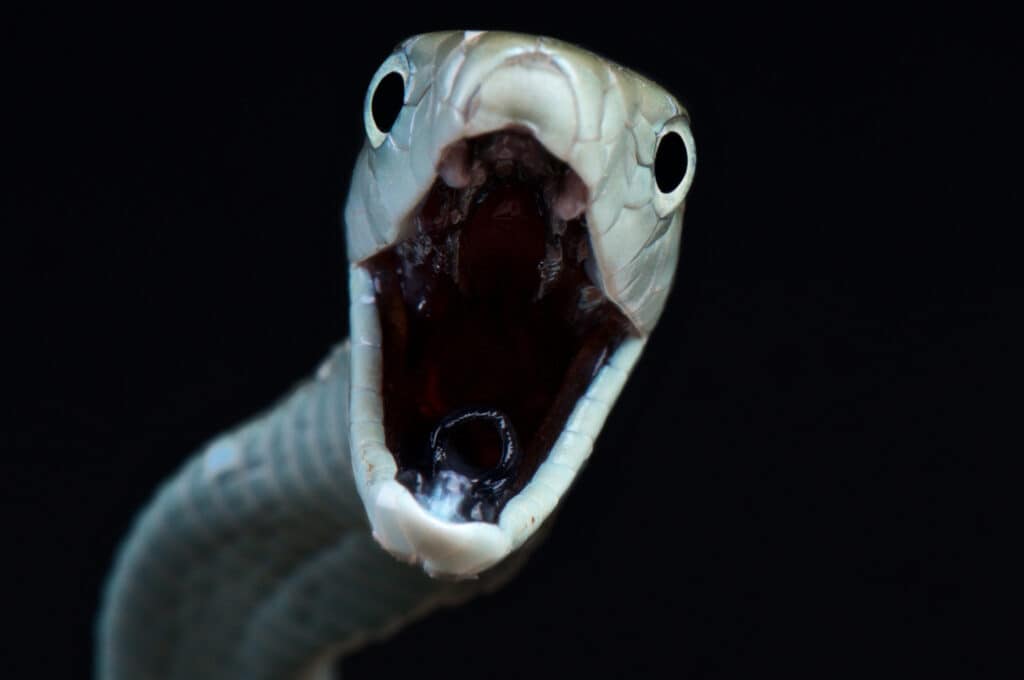
Black Mambas are skittish snake that doesn’t tolerate humans approaching too closely, and will most likely try to hide or escape first.
©reptiles4all/Shutterstock.com
More Snake Finds
Don’t forget to give these incredible snake pages a read!
- Anaconda: Discover the Heaviest Snake in the World
- Coral Snake: Learn about this Venomous Snake
- 46 Snakes in California (7 are Venomous!)
Black Mamba FAQs (Frequently Asked Questions)
Are black mambas venomous?
Yes. In fact, they have one of the most dangerous venom cocktails of all snakes.
How do they hunt?
Black mambas hunt during the day, retreating to a den at night; they bite and release their prey, allowing it to die before swallowing. However, they’ll hold onto birds so it doesn’t fly too far away.
Are black mambas aggressive?
Not really, they’re more skittish and nervous than anything. They only average one human snakebite victim per year.
Where do they live?
They have a wide range of locations across sub-Saharan Africa, though they seem most common in southern and eastern Africa.
What do black mambas eat?
They prefer mammals such as bushbabies and hyraxes; but also eat birds and their young, and occasionally other snakes
How are black mambas different than king cobras?
Black mambas and king cobras have a number of differences. First, they live in different places. Black mambas live in Africa while king cobras live in Asia. In addition, black mambas are smaller with a maximum size of about 14 feet while king cobras can measure 18 feet in length.
What's the difference between a black mamba and a green mamba?
There are many differences between black mambas and green mambas, including their size and coloring. Black mambas have a hood that is similar to cobras, while green mambas do not. They are also very different colors!
Who would win a fight between a black mamba and a rattlesnake?
A black mamba would win a fight against a rattlesnake due to its length and potent venom. A fight between these two would be decided by the ability to land that first strike and make it deadly.
Who would win a fight between a honey badger and a black mamba?
A honey badger would beat a black mamba in a fight. Honey badgers are agile and capable of avoiding the black mamba’s attacks. When the fight starts, both animals will look to land killing blows. They’re highly aggressive.
Who would win a fight between a black mamba and an inland taipan?
A black mamba would win a fight against an inland taipan because it’s larger and far more aggressive than the other snake.
Who would win a fight between a black mamba and a copperhead?
A black mamba would win a fight against a copperhead. Black mambas have just about every important advantage over the diminutive copperhead. They’re larger, faster, have deadlier venom, and can attack from farther away.
What are the differences between a golden lancehead and a black mamba?
The key differences between a golden lancehead and a black mamba are size, color, location, and type of venom they use.
What is the difference between a black mamba and a boomslang?
The key differences between a boomslang and a black mamba are appearance, distribution, species, prey, and predator. Typically, a black mamba is shorter than a boomslang. While boomslangs belong to the Colubridae family, black mambas belong to the Elapidae family.
Which is more venomous between rattlesnakes and black mambas?
Black mambas are more venomous than rattlesnakes.
What is the difference between a Gaboon viper and a black mamba?
The most significant differences between a Gaboon viper and a black mamba are their size, venom, and morphology. The Gaboon viper is a large snake that can measure 7ft and 45lbs, has a thick body and wide, leaf-shaped head with two horns, and injects the most venom of any snake per bite. The black mamba is a thin, long snake measuring 4.5lbs and up to 14ft, has one of the most potent neurotoxic venoms on the planet, and has a distinct black mouth.
How many types of mambas are there?
There are four species of mambas within the Dendroaspis genus. These include the black mamba, eastern green mamba, western green mamba, and Jameson’s Mamba.
Which is more venomous between a black mamba and a cottonmouth?
Black mambas are deadlier and more venomous than cottonmouths.
Thank you for reading! Have some feedback for us? Contact the AZ Animals editorial team.
Sources
- Symptoma, Available here: https://www.symptoma.com/en/info/black-mamba-snake-bite
- African Snakebite Institute, Available here: https://www.africansnakebiteinstitute.com/snake/black-mamba/
- IUCN Redlist, Available here: https://www.iucnredlist.org/species/177584/15627370
- Indianapolis Zoo, Available here: https://www.indianapoliszoo.com/exhibits/deserts/elapids/










